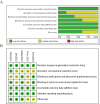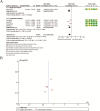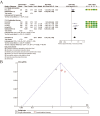Evaluation of the effectiveness and safety of combining PD-1/PD-L1 inhibitors with anti-angiogenic agents in unresectable hepatocellular carcinoma: a systematic review and meta-analysis
- PMID: 39355241
- PMCID: PMC11442381
- DOI: 10.3389/fimmu.2024.1468440
Evaluation of the effectiveness and safety of combining PD-1/PD-L1 inhibitors with anti-angiogenic agents in unresectable hepatocellular carcinoma: a systematic review and meta-analysis
Abstract
Background: Hepatocellular carcinoma (HCC) is a leading cause of cancer-related mortality globally, particularly when diagnosed at an unresectable stage. Traditional treatments for advanced HCC have limited efficacy, prompting the exploration of combination therapies. This systematic review and meta-analysis evaluate the effectiveness and safety of combining PD-1/PD-L1 inhibitors with anti-angiogenic agents in patients with unresectable HCC.
Methods: A comprehensive literature search was conducted in PubMed, Embase, Cochrane Central Register of Controlled Trials (CENTRAL), and Web of Science, including studies up to June 2024. Randomized controlled trials (RCTs) comparing combination therapy (PD-1/PD-L1 inhibitors with anti-angiogenic agents) to monotherapy or standard treatments in unresectable HCC patients were included. Data were synthesized using random-effects models, with pooled hazard ratios (HRs) for overall survival (OS) and progression-free survival (PFS), and risk ratios (RRs) for objective response rate (ORR) and adverse events (AEs).
Results: Five Phase III RCTs involving 1515 patients were included. Combination therapy significantly improved OS (HR: 0.71, 95% CI: 0.60-0.85) and PFS (HR: 0.64, 95% CI: 0.53-0.77) compared to monotherapy or standard treatments. The pooled OR for ORR was 1.27 (95% CI: 1.57-2.11), indicating a higher response rate with combination therapy. However, the risk of AEs was also higher in the combination therapy group (RR: 1.04, 95% CI: 1.02-1.06). Subgroup analyses revealed consistent benefits across different types of PD-1/PD-L1 inhibitors and anti-angiogenic agents, with no significant publication bias detected.
Conclusions: The combination of PD-1/PD-L1 inhibitors with anti-angiogenic agents offers significant benefits in improving OS and PFS in patients with unresectable HCC, although it is associated with an increased risk of adverse events.
Keywords: PD-1 inhibitors; anti-angiogenic therapy; combination therapy; hepatocellular carcinoma; overall survival.
Copyright © 2024 Zhu, Zhao, Chen, Zhu, You and Jin.
Conflict of interest statement
The authors declare that the research was conducted in the absence of any commercial or financial relationships that could be construed as a potential conflict of interest.
Figures







Similar articles
-
Single or combined immune checkpoint inhibitors compared to first-line platinum-based chemotherapy with or without bevacizumab for people with advanced non-small cell lung cancer.Cochrane Database Syst Rev. 2020 Dec 14;12(12):CD013257. doi: 10.1002/14651858.CD013257.pub2. Cochrane Database Syst Rev. 2020. Update in: Cochrane Database Syst Rev. 2021 Apr 30;4:CD013257. doi: 10.1002/14651858.CD013257.pub3. PMID: 33316104 Free PMC article. Updated.
-
Single or combined immune checkpoint inhibitors compared to first-line platinum-based chemotherapy with or without bevacizumab for people with advanced non-small cell lung cancer.Cochrane Database Syst Rev. 2021 Apr 30;4(4):CD013257. doi: 10.1002/14651858.CD013257.pub3. Cochrane Database Syst Rev. 2021. PMID: 33930176 Free PMC article.
-
Efficacy and safety of PD-1/PD-L1 inhibitors combined with anti-angiogenic therapy for the unresectable hepatocellular carcinoma and the benefit for hepatitis B virus etiology subgroup: a systematic review and meta-analysis of randomized controlled trials.BMC Cancer. 2023 May 24;23(1):474. doi: 10.1186/s12885-023-10960-w. BMC Cancer. 2023. PMID: 37226111 Free PMC article.
-
The efficacy and safety of PD-1/PD-L1 inhibitors in combination with chemotherapy as a first-line treatment for unresectable, locally advanced, HER2-negative gastric or gastroesophageal junction cancer: a meta-analysis of randomized controlled trials.Front Immunol. 2025 Mar 26;16:1566939. doi: 10.3389/fimmu.2025.1566939. eCollection 2025. Front Immunol. 2025. PMID: 40207218 Free PMC article.
-
Efficacy and safety of PD-1/PD-L1 inhibitors in advanced or recurrent endometrial cancer: a meta-analysis with trial sequential analysis of randomized controlled trials.Front Immunol. 2025 Jan 31;16:1521362. doi: 10.3389/fimmu.2025.1521362. eCollection 2025. Front Immunol. 2025. PMID: 39958346 Free PMC article.
Cited by
-
LPAR6 Inhibits the Progression of Hepatocellular Carcinoma (HCC) by Suppressing the Nuclear Translocation of YAP/TAZ.Int J Mol Sci. 2025 Apr 29;26(9):4205. doi: 10.3390/ijms26094205. Int J Mol Sci. 2025. PMID: 40362442 Free PMC article.
-
Efficacy and safety of PD-1/PD-L1 inhibitors combined with tyrosine kinase inhibitors as first-line treatment for hepatocellular carcinoma: a meta-analysis and trial sequential analysis of randomized controlled trials.Front Pharmacol. 2025 Mar 24;16:1535444. doi: 10.3389/fphar.2025.1535444. eCollection 2025. Front Pharmacol. 2025. PMID: 40196369 Free PMC article.
-
Tumor-associated lymphatic vessel density is a postoperative prognostic biomarker of hepatobiliary cancers: a systematic review and meta-analysis.Front Immunol. 2025 Jan 7;15:1519999. doi: 10.3389/fimmu.2024.1519999. eCollection 2024. Front Immunol. 2025. PMID: 39840048 Free PMC article.
References
Publication types
MeSH terms
Substances
LinkOut - more resources
Full Text Sources
Medical
Research Materials

